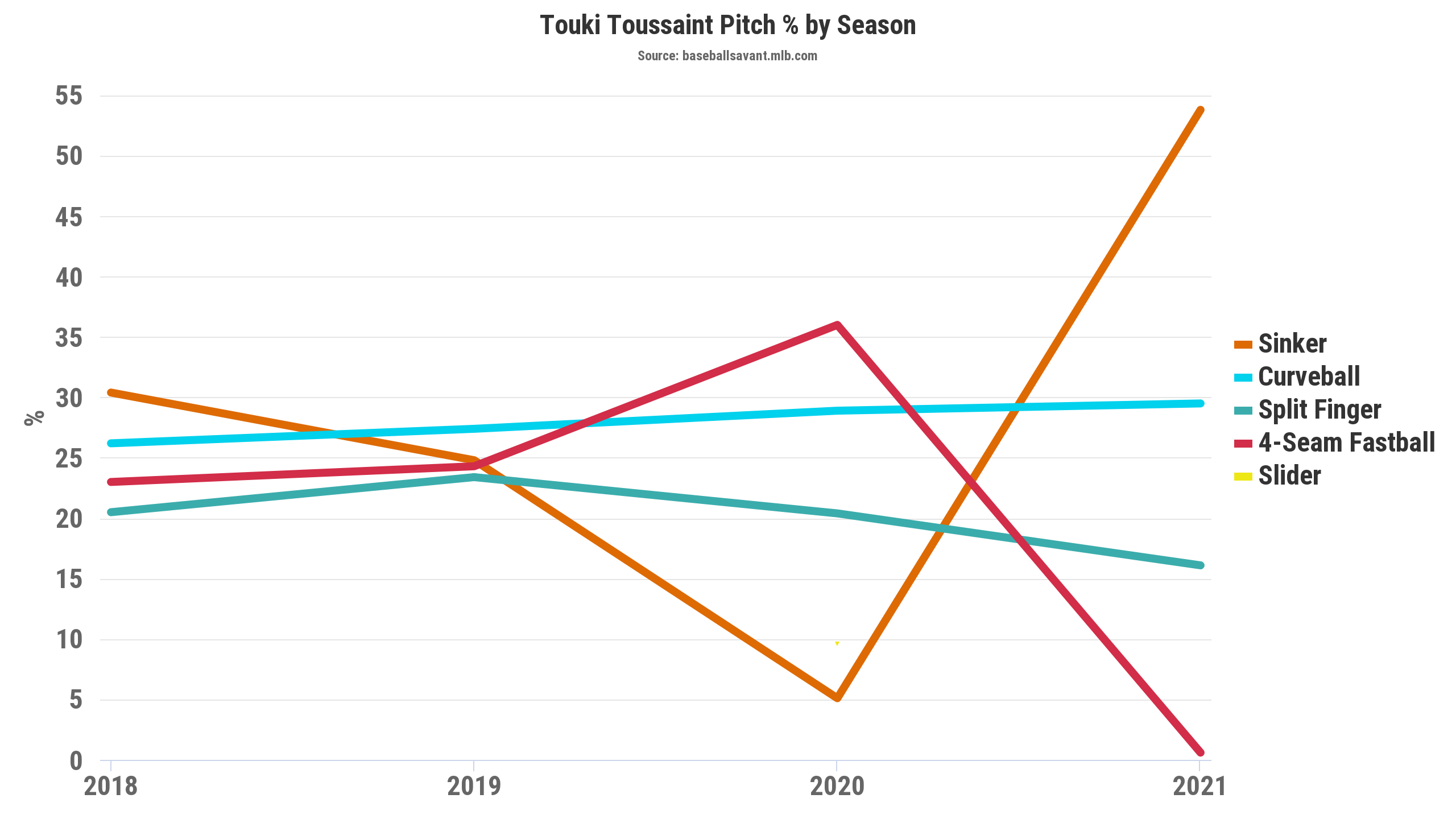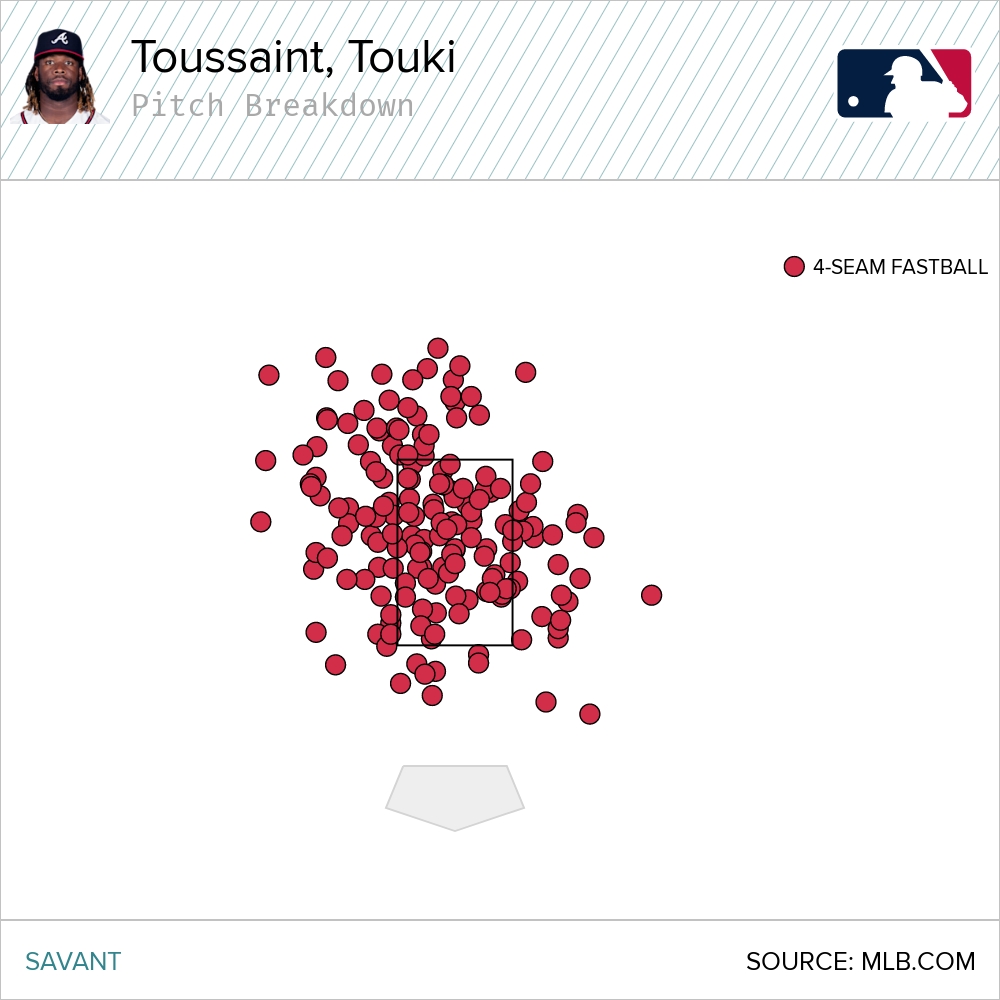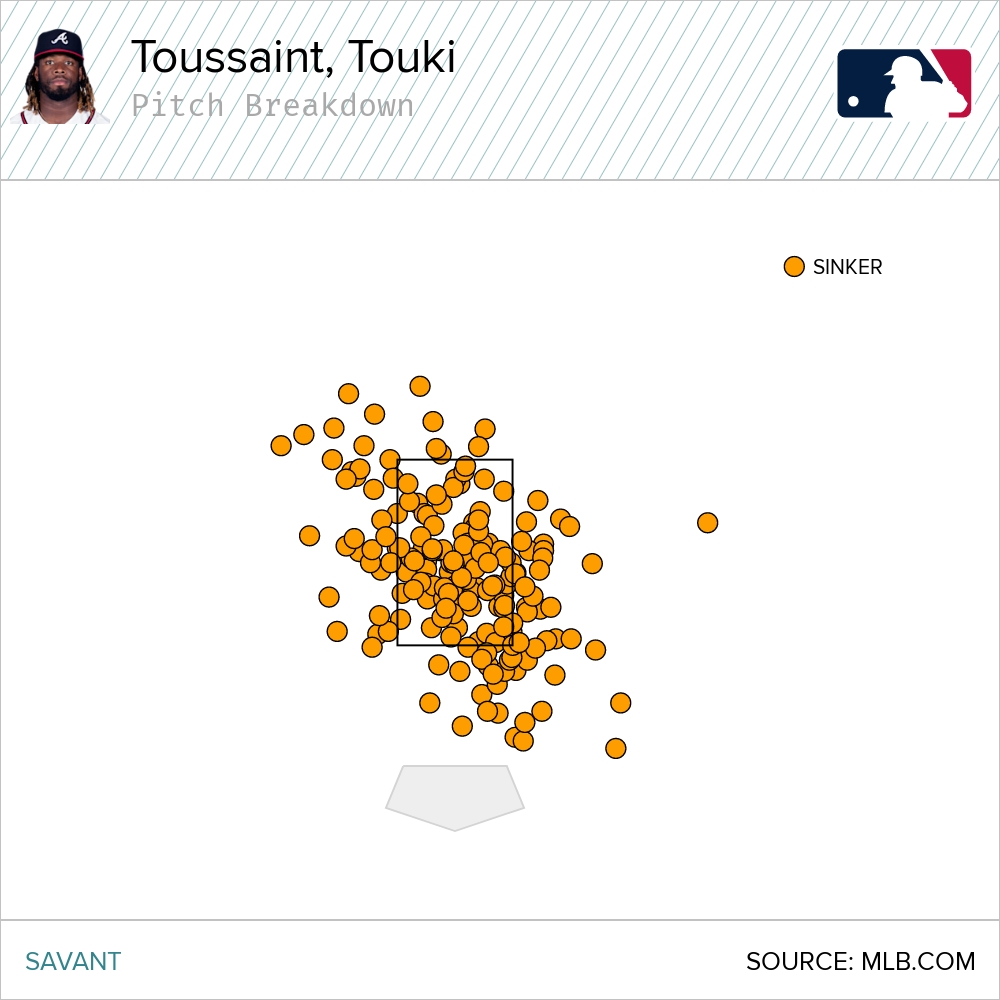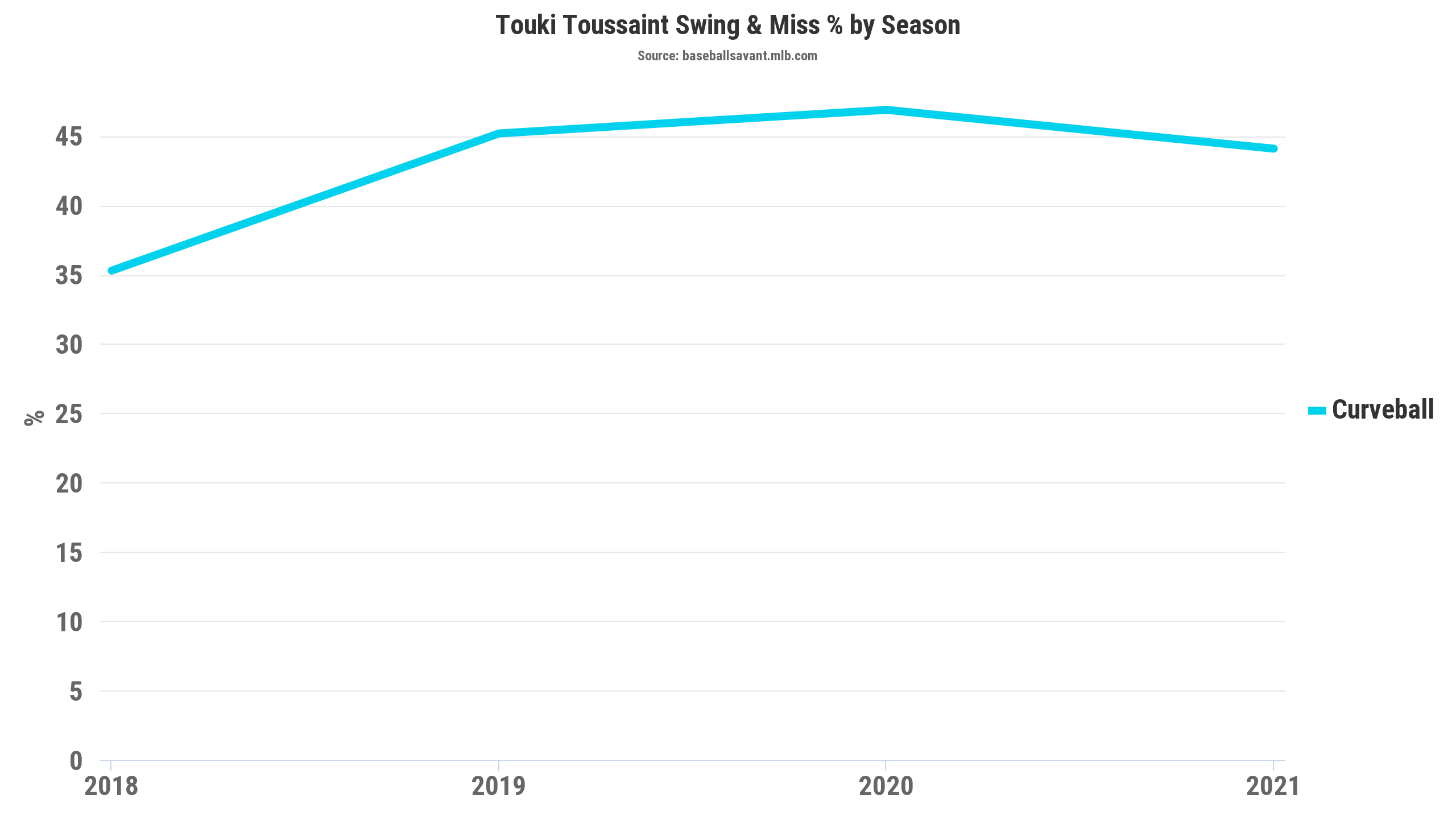It’s hard to believe that this season is already the fourth that Touki Toussaint has been a part of for Atlanta. It seems like he’s been around for so long at this point, as he was a constant guest on top-100 prospect lists since being drafted back in 2014. He made his Major League debut in 2018 at just age 22, and now at age 25, he still hasn’t quite fully found his footing at the Major League level, as he has yet to find consistent playing time or a solid role in Atlanta’s pitching plans.
He wasn’t initially expected to be a big part of their plans coming into this year, either. In the offseason, the team acquired other starters Charlie Morton and Drew Smyly, and the numbers game didn’t seem to favor Toussaint. A shoulder injury during Spring Training also didn’t help things, as that kept him on the shelf for an extended period of time. He pretty much missed the entire first half of the season and valuable development time after not throwing many innings last year.
Due to the natural pitching churn required during a Major League season, Toussaint is back from injury and is now in Atlanta’s rotation. He’s made four starts to this point, in which he has mostly been effective. A poor start against the Brewers on July 30th has been the outlier. In that one, he allowed seven runs in under four innings which has inflated his ERA some, but in his three other starts, he’s given up a total of just four runs, which looks a lot better. Overall, it’s still a sample of just 22.1 innings pitched, but his 3.80 SIERA looks quite impressive to this point, and this is perhaps a good indicator that Toussaint is starting to settle into and get more comfortable facing Major League hitters.
A big part of Toussaint’s effectiveness so far in the year has been due to how much he’s been able to limit walks. His pure stuff was never in doubt, as he has always shown strong strikeout ability during his brief tenures in the Majors and, of course, throughout his time in the minors. Instead, high walk rates have been what have held him back the most throughout his early career, with ugly walk rates of 17.1%, 13.1%, and 13.3% in his first three years spanning 2018 through 2020, respectively. He only pitched 95 innings total in that span, but it still was one of the highest walk rates in that span when looking at those pitchers with at least that many innings pitched:
That’s definitely not ideal, and even with the heavy amount of strikeouts that Toussaint featured, it still was difficult to have consistent success. Fortunately, this changed quite a bit for him thus far this season. It has been a night and day difference, as his 6.5% walk rate this year is over half of what it was last season and way down from the highs of his 2018 debut. It shouldn’t be too shocking, then, to see Toussaint as one of the starting pitchers with the greatest improvement in walk rate this season:
This dramatic improvement in terms of walk rate has, importantly, come with a still-strong strikeout rate of 24.7%. Of course, the small sample size caveats still definitely apply to Toussaint, but it is good to see, especially when considering that the cut-down walk rate seems to be reflected in the numbers. Most notably, his zone rate has been much improved this year, going from 43.6% last year to a much better 48.2% this year—a rate which is right around league average, as well as more pitches on the edge of the zone—essentially borderline pitches. This time, his edge rate has gone from 38.3% in 2020 to 41.2% this season, again much better and closer to league average.
All in all, it seems impressive for Toussaint that he has been able to work more in the zone and improve his walk rate, all while not sacrificing much, if anything, in terms of strikeouts. The below scatterplot pretty much shows it, as it looks at the differences in strikeout and walk rates for all pitchers the last two seasons, and we see that despite Toussaint, the point in red, lowering his walk rate by working more in the zone, his strikeout rate remains largely unchanged. This seems pretty unique among the rest of the league and implies that his stuff is still great despite that.

In an ideal world, we’d love to see his strikeout rate skyrocket and the walks be cut down even more, but this still looks to be a positive development for Toussaint. Just how much of this is real, though? Again, it has been just four starts after all, and he still has yet to eclipse his already-small innings total from last year. We’re definitely still dealing with a small sample, but at the same time, it is good to see improvement, and things start to shift for the better in what was his biggest weakness throughout his Major League career. Let’s take a closer look at Toussaint’s profile then and see what has changed that could be driving this sudden surge of strikes.
Let’s start first by looking at his pitch usage. One quick look at his pitch chart and one immediately obvious thing jumps out:

Toussaint appears to be throwing a lot more sinkers this year while pretty much scrapping his four-seamer. It does seem odd, and it may not be this dramatic, as the other pitch classification systems suggest that while he is throwing more sinkers, it hasn’t been as great of a shift as the tracker from Baseball Savant would suggest. But let’s just say that this is indeed fully accurate, and Toussaint really is throwing all of these extra sinkers. What might be the reason for this shift?
It does sort of go against the current thinking of pitching these days, as there aren’t as many pitchers favoring a sinker right now. However, if Toussaint is better able to control and locate his sinker as compared to his four-seamer, then that would seem like a win, as fastball command is maybe the top priority for a pitcher.
The early returns on his sinker seem to show this, considering the pitch’s zone rate is miles better than where his four-seamer has ever been:
Especially compared to last year, Toussaint’s sinker certainly seems like a better pitch to use in hopes of landing strikes in the zone. When looking at the pitch location charts, we can also see why the sinker might be a better choice. See his four-seam fastball pitch chart from last season, for instance:

Last year, it seemed like Toussaint was trying to focus more on the four-seamers up approach, which is right in line with modern pitching philosophy. While it did look like he was locating them mostly up in the zone, when he was missing, he was missing way up out of the strike zone, which would seem to be easier takes for hitters. Now, compare that to his sinker chart from this season:

The big difference here is that most of these sinkers are not up in the zone, which makes sense—they’re not supposed to be up in the zone. Rather, they’re more in the middle and bottom of the zone, but most importantly, they’re in the zone more consistently. Also, when he is missing outside the zone, he still looks to be missing closer to the strike zone than he was with the four-seamer last year. There are more pitches around the edge of the zone, which can still be called strikes, and they can still be enticing pitches for hitters to hit, rather than easy takes, as the case looked to be last year. It looks to be something of a tradeoff in that he may be leaving more pitches in the zone that are better for hitters to hit, but he’s now also able to land more pitches in the zone, which stops him from walking as many hitters.
As a plus to this approach, while the sinker will be left in the zone more often and hitters will make more contact, most of it will end up on the ground. That thinking isn’t new, as it is pretty much the big reason to go to such an approach in the first place, but it has been exactly the case for Toussaint so far this year. The pitch has done its job and then some, as his sinker has a groundball rate this year that is higher than his four-seamer has ever had, and it’s not even particularly close:
That shift in pitch usage likely explains why Toussaint’s overall groundball rate has spiked this year by over ten percent to 50.8%, which is a rate that is better than league average.
What separates Toussaint from other sinker ballers, though, is that he still gets his fair share of strikeouts, as we saw earlier. He has a more complete repertoire of pitches, so while he may not be getting as many whiffs with his fastball, it doesn’t exactly have to. It can serve its function as a strike-getter, and then he still has the option to turn not just one, but two other pitches that generate whiffs at a great rate.
The primary of which is his curveball, which has historically been his go-to secondary offering, and for good reason. The pitch is a whiff machine, and this year has been no exception, as the pitch sports a whopping 44.1% whiff rate this year, which is one of the highest rates among all curveballs in the league, and right in line with where it’s been since his debut:

Perhaps the pitch’s whiff rate will come down some in a larger sample, but either way, it is still hard to deny how effective a pitch it has been for him throughout the years. The curveball is also quite the thing of beauty, and when looking at it, it becomes pretty clear as to why the pitch gets so many swings and misses:
That on its own is great but now throw in that Toussaint also features a splitter that gets whiffs at a similarly high rate too. It’s definitely the third pitch in his repertoire in terms of usage at just around 16% of the time, but it still gets whiffs at an impressive 41.4% clip which, like his curveball, is one of the highest rates among all splitters in the game. It also does a good job of getting strikeouts with a 44.4% put-away rate, and when hitters make contact, it ends up on the ground 50% of the time, which would be expected. Again, it’s a pretty nasty looking pitch:
All in all, with two pitches with a whiff rate greater than 40%, it certainly seems that while Toussaint is perhaps sacrificing some whiffs by going with a sinker instead of a four-seamer, he is able to make up for it and still post a high overall strikeout rate due to the overall quality of his secondaries.
While Toussaint looks to have pivoted to featuring more sinkers and a pitching approach that is no longer in fashion as much as it once was, it is helping him out in a big way. He is better able to locate those sinkers in the zone for strikes, which has helped scale back what had been his biggest issue as a pitcher throughout his Major League career. It looks like a good recipe for him right now. Turning to the sinker is a trade-off, in that it may lead to more contact, which can get noisy, but it’s come with the benefit of better command, which seems to be more important in the long run for Toussaint if he hopes to stick as a starting pitcher. And it’s not as if he’s suddenly a slouch when it comes to strikeouts by turning to this approach. His strikeout rate has only changed by tenths of a percentage point this year, and that is due to him having two strong secondary offerings that get whiffs at some of the highest rates among their respective pitch group.
We’ll ultimately need to see if Toussaint can make these control gains stick, but the early returns look encouraging right now; it looks like Toussaint is finally on the road to living up to his high potential.
Photo by David John Griffin/Icon Sportswire | Adapted by Doug Carlin (@Bdougals on Twitter)

